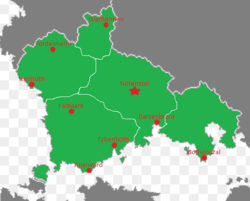States of Delkora
| Delkoran States | |
|---|---|
| Also known as: Delkorsk Stater (Delkoran) | |
 | |
| Category | Federated state |
| Location | Kingdom of Delkora |
| Number | 7 (as of 2019) |
| Populations | 953,421 (Lebøvenland) - 28,805,912 (Cybria) |
| Government | State government |
| Subdivisions | County Municipality |
The states of Delkora are the seven constituent states comprising the Kingdom of Delkora. As a result of Delkora's origins as a union of formerly independent fiefdoms, the Kingdom's states each maintain distinct regional cultures and identities that predate the Kingdom itself. Each is organized as a constitutional monarchy similar to the federal one.
History
The forerunners of the modern Delkoran states were various petty kingdoms that emerged between the 1st and 3rd centuries CE, which were later consolidated during Delkora's Viking Era.
Much of the Delkoran Middle Ages and Early Modern period were characterized by a vacillation of power between Delkoran monarchs and the regional jarls, with the national monarch sometimes commanding significant power, and at other times relegated to an essentially ceremonial figurehead. In either case, the monarch's reign was inevitably contingent on having the support of the jarls, who frequently moved to oust unfavorable monarchs.
Following the constitutional convention that convened at the conclusion of the Delkoran Civil War in 1833, the states continued to function as essentially absolute monarchies even as democratic reforms were adopted at the federal level. This changed with the Jarls Amendment of 1885, which reduced the jarls to constitutional monarchs and shifted power to the state parliaments.
Throughout the late 19th and early 20th Centuries, severe economic disparities began to emerge between different states as the northern states derived major benefits from booming trade, while the southern states experienced high unemployment, neglected infrastructure, and severe population loss as people moved to the booming southern cities. Efforts were made under the New Kingdom program of the 1960's and 70's to remedy these disparities. Major programs included the Federal Equalization Fund Act of 1964, the establishment of the Office of Rural Development in 1965, and the expansion of highway and railroad construction projects sponsored by the Federal Public Works Commission beginning in the late 1960's. These programs helped reduce economic inequality between the states, but some disparities exist to the present.
Regionalism and, in some cases separatism, have been salient issues in recent decades. The state of Lebøvenland has long had a unique cultural identity and has been host to a small but notable separatist movement.
Government
Each Delkoran state is governed by a directly-elected state parliament that has the authority to pass laws related to any of the powers granted to it by the federal constitution, as well as any not delegated exclusively to the federal government. All five state parliaments are elected using some variation of proportional representation, with elections occurring every four years, typically in years that do not coincide with federal elections. All five are unicameral.
After an election, parties attempt to form a government in a manner similar to the Federal Parliament. The resulting executive cabinet is led by a first minister who serves as head of government and is collectively responsible to the state parliament.
Each state has a constitutional court that is the ultimate authority on all questions involving the meaning of its constitution. State constitutional courts have the power of judicial review with respect to laws passed by their state and actions taken by their state government.
The jarls serve as mostly ceremonial heads of state, granting royal assent to state laws, presiding over the opening of parliament and other official events, dissolving parliament at the expiration of a term or the state government's loss of confidence, representing their state within the Kingdom and, with the consent of the federal government, foreign nations, and serving as commanders-in-chief of their respective states' Home Guard.
Like the national monarch, they possess theoretically wide-ranging reserve powers that can be exercised in times of crisis. Under the Delkoran Constitution, the jarls are considered co-equal to the national monarch, meaning they are each at the apex of their own separate royal hierarchies that are independent from the federal one. Accordingly, they can issue peerages, establish orders of chivalry, and otherwise exercise their royal prerogative without input from the national monarch, and can also not be compelled to render an oath of loyalty to them.
Subdivisions
Each state is divided into counties, which consist of groups of municipalities. The entire territory of Delkora is divided into municipalities, with no unincorporated areas. As a result, some municipalities consist of only a few small towns and large stretches of uninhabited forests or grasslands. Their powers and responsibilities vary from state to state.
As of 2019, there are 372 counties in Delkora and 4,658 municipalities.
List
| Flag | State | Capital | Head of State | Head of Government | Legislature | Population | Chamber of Representatives Seats |
|---|---|---|---|---|---|---|---|
| State of Banderhus |
Falbaard | Jarl Toren IV | Asbjørn Bonde (K) | Banderhus Parliament | 14,005,519 | 75 | |
| State of Cybria |
Eldenvard | Jarl Æsa VII | Astrid Marett (A) | Cybrian Parliament | 28,805,912 | 155 | |
| State of Førelskov |
Gothendral | Jarl Gustav III | Anjela Hansen (L) | Førelskov Assembly | 23,782,252 | 128 | |
| State of Lebøvenland |
Raikonir | Jarl Henriette IV | Elin Albrechtsen (K) | Lebøvian House of Representatives | 953,421 | 5 | |
| Free City of Norenstal |
- | - | Eva Dafengaard (A) | Norenstal Assembly | 8,528,475 | 46 | |
| State of Norvia |
Grafholmen | Jarl Brette VIII | Bárður Ólavsson (L) | Norvish House of Delegates | 5,182,742 | 28 | |
| State of Vassengård |
Izenhoth | Jarl Harald III | Tobias Bidstrup (L) | Vassengård Parliament | 11,785,621 | 63 |